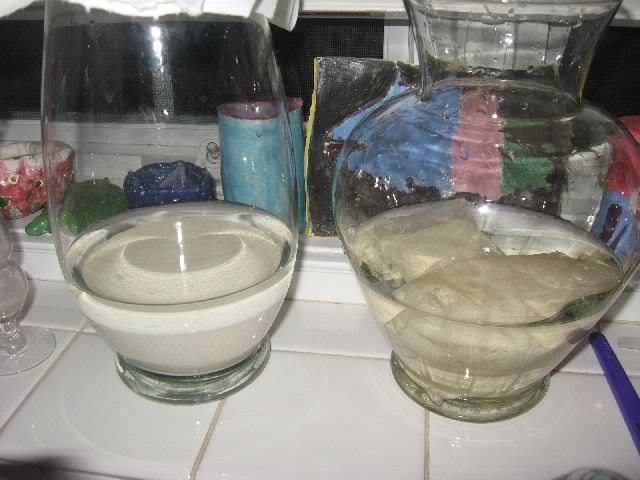I have been using Seachem Purigen on my planted tanks and saltwater tanks that I maintain for others. This article describes my personal method for recharging the product. It is based on my experience and a pH crash in a small tank that was duplicated and verified by Seachem, causing a change to the product label and me getting a bunch of free stuff.
I really like Seachem’s Purigen product. Since I run across a lot of people curious about alternatives to chemical filtration with Activated Carbon and other materials, and I find myself spouting off about Purigen and how to maintain it, I figured it would be worthwhile to write a thread about how I recharge it. I originally heard about the product on www.plantedtank.net where I was told it was the choice of many as an alternative to carbon. It has proven to me to be every bit as effective as they claim.
In case you are not familiar with Purigen, it is a synthetic polymer resin that has been marketed as having the ability to reduce ammonia, nitrite, nitrate, etc. It actually does not. It removes dissolved organic matter BEFORE it gets consumed by nitrifying bacteria, therefore it will reduce the resulting buildup of Nitrate. It also has a water-polishing quality, as it adsorbs a wide variety of chemicals. However, unlike activated carbon, it won’t remove nearly the amount of nutrients that plants require (fertilizer supplements). For more information, read the information on their website for Seachem Purigen.
The describe the recharging process on that page down at the bottom. I follow about the same procedure, with a few variations. First, you have to know when to recharge. This is what it looks like out of the box
And this is what is looks like by the time it needs recharging. The larger bag on the left is out of a FOWLR tank and is 250 mL, the middle bag is from a reef tank, and the one of the right is from my little overstocked 10g fry tank.
For some reason, when used in SW it takes on a more brownish and even coloration, while in FW it ends up more salt-and-pepper looking, some beads will turn almost black and some stay pretty light. I don’t know if this is because of their position in an HOB or canister in FW versus a sump in SW, but it’s just an observation. The Purigen is ready to recharge whenever it has for the most part changed color to brown or black (or about ½ of the beads are black) in my opinion.
What you will need to recharge Purigen:
1) A glass container. I’ve used a Ball Jar, but I find that a large flower vase works better due to Purigen’s stickiness.
2) Bleach (not a cleaner containing bleach, just plain old bleach)
3) Prime (I do not suggest using other dechlorinators)
4) Old toothbrush
5) Paper towels
First, I start by rinsing the product very well in luke-warm tap water. I prefer to use a flower vase like this one
And I prefer to empty the contents out of The Bag into the vase but you don’t have to (you just have to stir it more often). Since the product sinks, I open the bag and dump the beads out into the vase, then run the bag under slow-running water to rinse the beads out.
The beads will quickly (1 minute) settle to the bottom
Then I slowly pour out the water, the key here being SLOWLY so that the Purigen doesn’t get stirred up. You can’t pour all the water out so don’t try.
Then I rinse again
Repeat until the water is clear after the purigen settles out
And pour off the excess, leaving a little bit left
Then I pour in the bleach
Give it a good swirl
Top it off with water (I use RO)
And watch it almost instantly turn white
This happens in literally less than a minute. But let it soak for a full 24 hours.
If you keep the product in The Bag or you have the 100mL pre-bagged ones, it’s a similar procedure. You rinse well in luke-warm tap water
Get a glass vase
Pour in the bleach
Top it off with water
And soak
As you can see, I use the handle of a toothbrush to stir up the mix a couple times a day. With the product out of the bag, it’s easy. In the bag, IMO you have to swirl and prod and turn the bags to make sure the entire product is getting some bleach contact
I also cover the glass containers with paper towel, because the surface of the water will skin over or something overnight. Not sure why, but I’m sure it’s fine, I just prefer to cover it.
I also bleach “The Bag” separately
I use “The Bag” for RowaPHOS and some other stuff, so they get stained. This doesn’t affect their functionality as far as I can tell.
After 24 hours, I pour off the bleachwater and rinse the loose beads about 3 or 4 times (at least) and take out the pre-bagged ones and rinse them for about 2-3 minutes each under the faucet (after rinsing in the vase several times). It looks brand new now!
But it’s not ready. I pour off all possible water, then add Prime (ONLY USE SEACHEM DECHLOR PRODUCTS FOR THIS STEP)
To about here
Then mix in some RO water
And let that soak for another 24 hours. Now, as you’ll notice below, it looks the same color as the new bag, if not even a little whiter.
For the loose media, at this point you pour it back into “The Bag” which isn’t that hard, except for the last few beads. You get the product all mixed up and just pour it into The Bag. The beads will stick to the container, and you’ll have to wash them back down, swirl and quickly pour several times to get them all. Then zip-tie The Bag.
At this point (after thoroughly rinsing) Seachem says it’s ready for use as long as it doesn’t have a bleach-like smell, and if in doubt, to soak in pure water for a while and test for chlorine residue. I prefer to take the next preventative step (next paragraph) to ensure that the product is completely neutral. I do this to ensure that it doesn’t throw off the pH in the tank you put it in. This is what happened to me before they changed their directions. There used to be an extra step for FW to soak in Acid Buffer or Discus Buffer, and when I put a 100mL bag in my 10g after recharging, it tanked the pH. I brought it to their attention and they duplicated the process I went through and verified it, then changed the label and I got a bunch of free stuff. Yay me! So anyways, I did this process and tested the pH along the way and found out that in a small volume of water (5g) it still will swing the pH, not nearly as much as it did after soaking in Acid/Discus buffer, but it still does – maybe from 9.5 to 8 in an hour in 5g. Probably not noticeable in a 30 or 55 or bigger, but in a 10g a half-point swing in an hour could cause problems. “Rinse well” is completely relative!!!
Anyhoo, I take the Purigen and put it in a 5g bucket and fill it with luke warm tap water, then put in a power head and a tiny bit of prime to dechlor and let that run for about an hour. Make sure the power head has an intake guard or foam on it. Very little chance of it, but the edges of The Bag could get sucked into the impeller and that would be bad.
Here’s the pH at the start
And here it is at the 1 hour point
At this point (1 hour) if the pH has dropped much more, I would dump out the water, fill again, dechlor, and run the powerhead for another hour. Repeat as many times as you need, but it should be OK after the first cycle through. Keep in mind that this is 450mL of purigen in a 5g bucket and it dropped about 1.5 points. This is enough purigen for a 450 gallon tank. You wouldn’t notice a change in pH at all in that size system, or even in a 45 gallon system for that matter. This is just an extra ‘safety’ step.
At this point, it is ready for use in your aquarium for another extended period of time depending on your bio-load and your tap water quality. Mine lasts at least 6 months.
I rinse it well during each filter cleaning with luke-warm tap water to make sure it’s free of trapped waste, stays mixed up (in my canister, I take it out and the coloration will be striped black/white where the water flows up through the tray), and more importantly to make sure The Bag material stays porous.
The whole process maybe costs $5-10 in materials, including the vase, bucket, bleach, and Prime. Prime being the most expensive part, unless you have to buy the flowers to get the vase. In the long run, you spend a lot more time and money on activated carbon between rinsing and replacing. Save that carbon for taking out meds to use it in your RO pre-filter!
One additional note I will add: Occasionally, you will encounter a tear along the seam of the micro-mesh bag. In fact, when I was taking these pictures I discovered one. This is easy to fix, as long as the break is on the seam, which it almost always is. The material that the bag is made out of is nylon, so just like you can melt the ends of a nylon rope together so it doesn’t fray, you can re-seal a seam. Simply find the break, rinse the Purigen away from that area and dry it with a paper towel. Hold the bag so that the broken edges are together or as close as you can get, sweep a cigarette lighter back and forth quickly a couple times, then use a dry paper towel to give a quick squeeze on the joint (so that the melted nylon doesn’t stick to your hand and burn you) to seal it. You can repeat this a couple times, but make sure it cools down an hardens in between each sweep, or else you can burn a hole in the bag and then it’s useless. Run it under luke warm water to test and you’re good to go!































